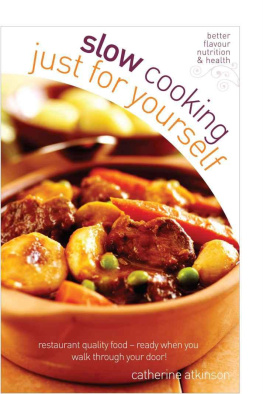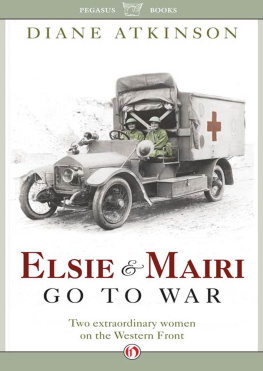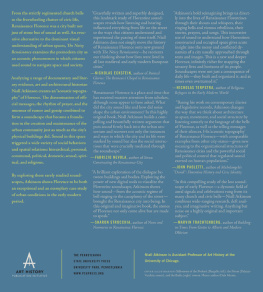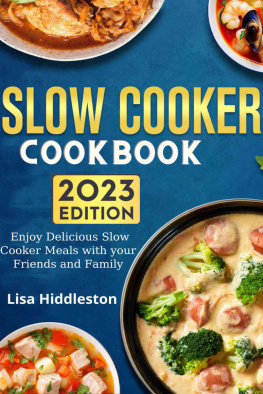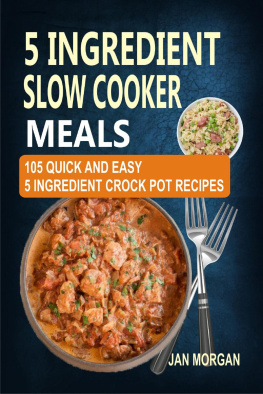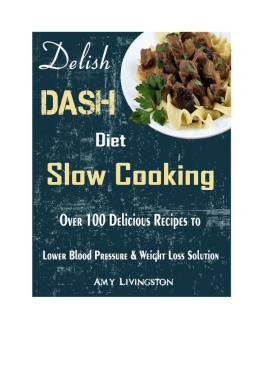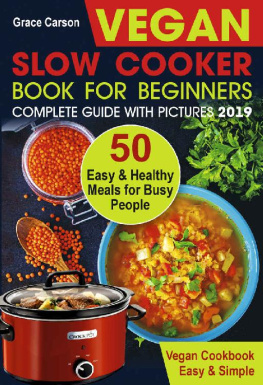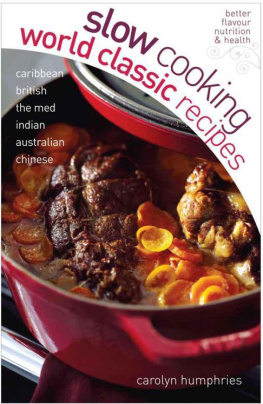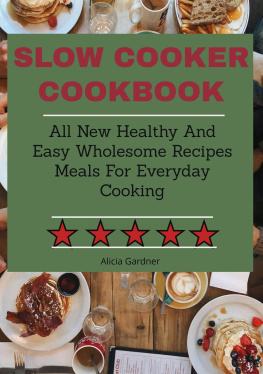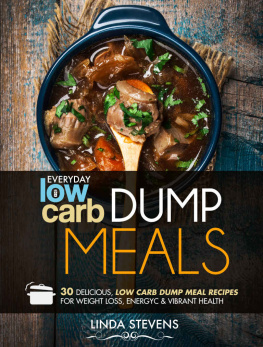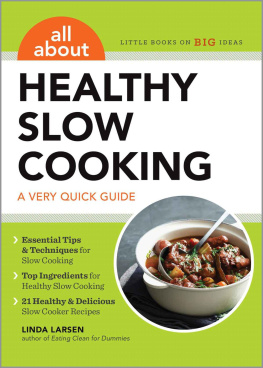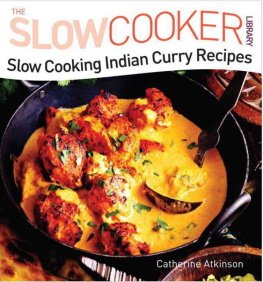
Table of Contents
Introduction
Whether you live alone or are simply having a solitary night in, cooking can be a chore and it may be the last thing you feel like at the end of the day. It's all too easy to dash out for a takeaway or settle for a chilled ready-made meal from a packet. Slow cooking is the perfect way to create flavour-packed meals with the minimum effort and fuss. Ideal for soups, casseroles, vegetables and desserts, this method of cooking means that you can prepare meals in advance and simply leave them unattended to cook for as many hours as they need.
The basic principle behind the slow cooker is that it cooks food slowly at a low constant temperature. This has many advantages. One of the greatest is that it develops and enhances the flavour of food, while retaining its texture. It brings out the sweetness in fruit and vegetables and makes even the toughest meat meltingly tender - in fact, the less expensive cuts are better suited to slow cooking. Slow cookers are also environmentally friendly; their low wattage consumes about the same amount of electricity as a light bulb. A bonus is that food is unlikely to burn or over-dry; if you're out for the day, an extra hour of cooking won't ruin your recipe, so there's no need to worry if you get home a little later than planned. The principles of slow cooking are incredibly simple, but do have a look at the following few pages before you begin.
All the recipes in this book have been created to use a range of ingredients that are easy to buy on a small scale. They are designed for one, but many make two servings - one to serve straight away and one that can be jazzed up the following day (you'll find plenty of suggestions for this), or frozen for a later date. There are mouthwatering meals to suit every occasion from light lunches and midweek meals to delectable desserts. Solo eating will never be the same again!
Choosing a Slow Cooker
Slow cookers now come in a huge range of colours, shapes, sizes and prices and these factors need to be considered before you make your choice.
Appearance is the first thing you'll notice; you'll find contemporary stainless steel, vibrant coloured and pristine-looking white models as well as the rustic-looking cream versions. Originally only round slow cookers were available; these are excellent for soup and casserole making and for cooking puddings in basins and cakes in round tins. The more modern oval version is a better buy if you entertain often as it's perfect for pot-roasting larger joints of meat and is also good for cooking loaf-shaped cakes and pts. The heat-resistant lid may be ceramic or toughened glass. The advantage of the latter is that you can monitor the food's progress without having to lift the lid and lose precious heat.
The size of slow cookers ranges from a tiny 600 ml/1 pt/2 cup cooking pot to a massive 6.5 litre/11 pt/27 cup one. I have found the ideal size to be 1.5 litres/2 pt/6 cups; a large enough capacity for two portions, but small enough to ensure that food such as portions of fish or meat will fit snugly inside and be covered by the cooking liquid.
Using and Caring for Your Slow Cooker
Because slow cooker models vary, make sure you read the manufacturer's guide book before using yours for the first time. Some slow cookers need to be preheated before you start cooking; others advise against heating the slow cooker when empty. You should also check to see whether yours is dishwasher proof and whether it can be used under the grill (broiler) and in the oven, in the microwave or the freezer.
Before use, wash the ceramic cooking pot in hot soapy water, rinse well and dry. You may notice a slight odour as the slow cooker heats up; this is caused by the burning off of manufacturing residues and should disappear after the first few uses. Don't worry if the glaze on the ceramic becomes slightly crazed; this is perfectly normal.
You'll notice that the recipes here advise using hot (not boiling) water and stock when adding it straight to the cooking pot; never pour boiling liquid into the cold cooking pot (you can do so when it is already warm or hot) or plunge it into cold water immediately after use as this could crack it. Remember that it is an electrical appliance, so the outer casing should only be wiped clean and never immersed in or filled with water.
When following a recipe, bear in mind that every model is slightly different and, even when using the same settings, some will cook faster than others. For this reason a range of cooking times is given; you may need to use the shorter or the longer time, or somewhere between the two. After trying a few recipes, you will know whether your slow cooker is faster or slower and you will be able to adjust the recipe cooking times accordingly.
During cooking, steam condenses on the lid of the slow cooker, then trickles back into the pot, helping to retain heat and reduce strong cooking smells. Unless a recipe tells you to stir a dish part-way through cooking, it should be left undisturbed and you should avoid lifting the lid.
Cooking Times
The cooking temperatures and settings vary on different models, but most have four settings: Off, Low, High and Auto. Some models have an additional Medium setting. At the lowest temperature the food will barely simmer, at the highest it will cook at just below boiling point or boil very gently
When set to Auto, the cooking temperature will build up to High, then remain at this temperature for an hour or so before automatically switching to Low. Some flexibility can be introduced to the total cooking time by adjusting the temperature setting. Some foods however, such as poultry and cakes, should always be cooked on High or Auto for at least the first hour of cooking.
For dishes such as soups, braises and casseroles, the cooking can be shortened or extended to suit your needs by changing the temperature setting. As a rough guide, the cooking time on Low is about double that of High.
Slow Cooker Safety
The slow cooker is an extremely safe appliance, but common-sense precautions should be followed. Although it cooks at a low temperature, the outer casing, lid and the food inside the slow cooker may get extremely hot, so you should always use oven gloves when removing the ceramic cooking pot. Stand the slow cooker on a heat-resistant surface when in use, not near the edge where it might accidentally get knocked off, and make sure that the mains lead is tucked safely behind it. Take extra care that it's out of reach if you have young children or inquisitive pets living or staying with you.
- Slow cookers cook food at a relatively low heat - around 90C/195F on the Low setting to about 150C/300F on the High setting. Bacteria in food is destroyed at 74C/165F, so as long as it's cooked for the correct time, the temperature of the slow cooker will ensure that the food is safe to eat. You should take care, however, not to reduce the cooking temperature:
- Do not lift the lid during the cooking time unless the recipe specifies this.
- Make sure that ingredients are at room temperature when you start and never add frozen or part-frozen foods.
- Increase the cooking time slightly when the kitchen temperature is extremely cold, for example if you are cooking overnight.
- Avoid placing the slow cooker in a draughty place or near an open window.
- Always check that meat is thoroughly cooked, particularly poultry and pork. A meat thermometer is a good investment if you cook portions or joints of meat as it will ensure they are sufficiently cooked without drying out and loosing moistness.
Next page
